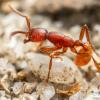I agree with Myrmica.
- Formiculture.com
- Forums
- Gallery
- Members
- Member Map
- Chat

I agree with Myrmica.
My Main Journal | My Neivamyrmex Journal | My Ant Adoption | My YouTube
Join the TennesseeAnts Discord Server! https://discord.gg/JbKwPgs
The key provided if followed through as 12 antennal segments will easily follow to Myrmica.
Edited by PurdueEntomology, December 11 2020 - 1:57 PM.
I think it looks a bit like an ant
19, 20, 21, 22, 23, 24, 26, 27, 28, 29 is the key I followed. Some of the options I just ignored and didn't consider, like Cardiocondyla or Monomorium, so the key was pretty quick and not very thorough. Arrived at Myrmica, which confirmed my gut feeling at the start.
My first thought was Myrmica, sculpturing on head body, and more importantly shape of petiole and post petiole are what caught my eye.
My first thought was Myrmica, sculpturing on head body, and more importantly shape of petiole and post petiole are what caught my eye.
I was thinking either Myrmica or Stenamma.
My Main Journal | My Neivamyrmex Journal | My Ant Adoption | My YouTube
Join the TennesseeAnts Discord Server! https://discord.gg/JbKwPgs
My first thought was Myrmica, sculpturing on head body, and more importantly shape of petiole and post petiole are what caught my eye.
I was thinking either Myrmica or Stenamma.
Eye size and the very rugose sculpturing rule out Stenamma. Stenamma have rather small eyes and the sculpturing is usually very fine and punctate, and also covered in short hairs.
Good job, Myrmica is one of the trickier genera.
My first thought was Myrmica, sculpturing on head body, and more importantly shape of petiole and post petiole are what caught my eye.
I was thinking either Myrmica or Stenamma.
Eye size and the very rugose sculpturing rule out Stenamma. Stenamma have rather small eyes and the sculpturing is usually very fine and punctate, and also covered in short hairs.
I thought the opposite tbh.
My Main Journal | My Neivamyrmex Journal | My Ant Adoption | My YouTube
Join the TennesseeAnts Discord Server! https://discord.gg/JbKwPgs
My first thought was Myrmica, sculpturing on head body, and more importantly shape of petiole and post petiole are what caught my eye.
I was thinking either Myrmica or Stenamma.
Eye size and the very rugose sculpturing rule out Stenamma. Stenamma have rather small eyes and the sculpturing is usually very fine and punctate, and also covered in short hairs.
I thought the opposite tbh.
Stenamma also tend to have shorter propodeal spines and a prominent petiolar "stem" where it connects to the propodeum. I do agree with Myrmica on this one though, especially due to the highly prominent sculpturing and long propodeal spines. I could recommend some keys to get this one down to species if needed. I know Myrmica are real tricky, but it's worth a shot.
Currently Keeping:
Camponotus chromaiodes, Camponotus nearcticus, Stigmatomma pallipes, Strumigenys brevisetosa, Strumigenys clypeata, Strumigenys louisianae, Strumigenys membranifera, Strumigenys reflexa, Strumigenys rostrata
0 members, 0 guests, 0 anonymous users